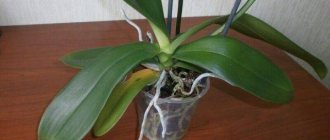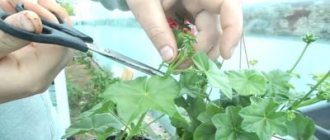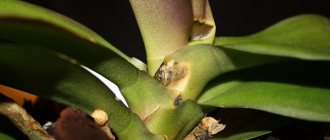White orchids are flowers that were first discovered in Indonesia and Southern China. Today the plant can be found on the plains and in tropical forests, as well as on the windowsills of most orchid lovers. Phalaenopsis has captivated flower growers so much that they do everything possible to keep the flower blooming and developing.
Considering that the presented species of orchids blooms regardless of the time of year, you can enjoy snow-white blooms almost all year round. With proper care, the plant will bloom for more than 6 months a year.
What is it like: home care
Many gardeners worry that care at home will require a lot of effort and time. Although this is not at all true.
Breeders bred the white phalaenopsis orchid just for home cultivation. Therefore, you don’t need to worry about the temperature in the room being unsuitable or having to constantly worry about air humidity. But it has not yet been possible to breed a completely black orchid, although there are some species that are very close to this color.
All care usually comes down to the following points:
- landing;
- lighting;
- watering;
- feeding;
- soil;
- pruning and replanting.
By adhering to some rules, it will be possible not only to grow white orchids, but also to propagate them.
Landing
It is recommended to plant a white orchid in a transparent pot. You need to pay attention to the fact that there are small holes at the bottom for aeration. Before planting the flower, drainage must be poured onto the bottom. Beginning flower growers are recommended to buy a special substrate in stores. Those who already have experience growing similar flowers can prepare the soil themselves. To do this, you will need to take dry bark, a little sphagnum moss and charcoal.
Lighting
Without light, the orchid will die, so it needs to be provided with good lighting. In the summer, a flowerpot with a flower can be placed relatively close to the window. However, you need to make sure that the plant is not exposed to direct sunlight all day. In winter, you may need an additional light source, such as a fluorescent lamp.
Despite the fact that phalaenopsis takes root well at any temperature, it is best that it is within +20..+23°C. A mark below +15 °C is quite alarming; at low temperatures the plant may even die.
Watering
The white orchid does not require frequent spraying or watering. As soon as it has been noticed that the tree bark (and this is the main part of the substrate) has dried well, manipulation can begin. In hot weather, the flower is usually watered a couple of times a week, and in winter, when the room is cool enough, the procedure can be carried out no more than three times a month.
Important! During flowering, the flower is watered from a watering can and is not moved from place to place.
Only clean water should be used. There can be no talk of any liquid from the tap. Considering that some apartments are very hot in winter, the plant may not have enough air humidity. In order to provide it to the flower, you should spray the phalaenopsis with a spray bottle or place a jar of water nearby.
Top dressing
There is no need to rush to fertilize the flower immediately after it was purchased . Fertilizers are applied only after a couple of years. They are sold in flower shops. Moreover, a non-blooming orchid is fertilized once a month, but a flowering orchid is fertilized 2-3 times a month.
The soil
Most gardeners buy ready-made substrate in stores. In principle, this is a good idea, since it practically eliminates the possibility of various pests getting into the flower with the soil. Although, if you do everything correctly, you can make your own soil mixture.
To do this you need to take:
- tree bark (4 parts);
- sphagnum moss (1 part);
- charcoal (1 part).
And mix it all well. The bark must be well dried and pre-boiled to prevent pests from entering the soil. It is also necessary to ensure that all components are neither large nor small in size. Because in the first case the substrate will be very large, and in the second it will resemble dust.
Selection and transplant
When buying an orchid, you need to carefully examine it. They are sold in transparent containers. If the flowers are shiny and richly colored, it means that the orchid was not stored in the store for long. The flowers are dull and soft - the orchid costs at least a month, it is not recommended to buy such a plant. The leaves should be glossy, without black spots or signs of wilting. White orchids should have gray roots. After purchase, the plant is treated with fungicides.
First choose the right place for the flower. It should be well lit and protected from direct sunlight. The most suitable place is considered to be a window sill located on the east or southeast side. Daytime temperatures should not exceed +25°C, and at night they can drop to +16°C.
The orchid is planted in a special substrate, and not in the ground. You can make it at home or buy it ready-made in the store. To prepare the substrate, boil and dry the pine bark. Repeat the procedure after a few days. Next, cut the bark into 2 cm pieces, then mix with dry sphagnum moss.
Flower growers recommend using a white or transparent pot for the plant. A container of this color does not heat up in the sun. It is necessary to drill holes at the bottom of the pot so that the water does not stagnate. Place drainage made from small pieces of polystyrene foam for better water flow. Then place the substrate in a pot and place the orchid in it. After planting the flower, add the remaining mixture. It is recommended to replant the orchid every 3 years.
How does a white orchid reproduce?
White phalaenopsis is quite difficult to breed. The interesting thing is that even experienced gardeners sometimes cannot do this.
However, everyone should know how the procedure is carried out in order to have at least some idea about it.
So, reproduction occurs:
- By dividing the stem (usually this method is used to rejuvenate the flower).
- Children. They appear on the peduncle. This happens rarely, but it does happen.
- By seating. If several rosettes with separate roots appear, then you should not hesitate, but plant them in separate flowerpots.
White varieties
An inexperienced florist is unlikely to be able to visually determine which variety his beauty belongs to, although some species still have noticeable differences. We will introduce you to the most common varieties.
Let's start with the gorgeous Apple Blossom. This particular orchid was called white. The plant produces a medium-sized flower (up to 8 cm in diameter). The petals are truly pure white. The orange-pink center looks like a brooch pinned to a snow-white dress.
Amalfi is also a white variety. However, the flower petals have a juicy lemon color. The core is painted in a rich pink color. A large delicate flower will be a magnificent decoration for any windowsill.
Almeria is one of the most popular varieties. She is attractive with her unusual color. It looks like someone splattered maroon ink onto the white petals. Several beautiful flowers bloom on one arrow.
Atlantis produces relatively small flowers – up to 7 cm in diameter. This fuchsia beauty is also a white variety. It is chosen for its bright and very rich color. This orchid will decorate any interior and can become a welcome gift for friends and family.
Pests and diseases of flowers
Often the plant is affected by various types of rot. This is due to an incorrect watering scheme. Fearing that the flower will dry out, flower growers begin to carry out uncontrolled irrigation or “soaking”. Of course, this leads to excessive soil moisture and root rotting. In order to eliminate this, you need to forget about watering for a while (for a couple of weeks), and then proceed according to the scheme.
If this does not help or the root system is already very rotten, then you cannot do without special means (such as phytosporin-M, for example).
Pests, if they do not bypass the white orchid, then attack it extremely rarely. You also need to fight parasites using special solutions.
Reproduction
Basically, phalaenopsis reproduces by children, which are daughter plants of the flower. To stimulate their occurrence and further growth, it is necessary to adhere to the basic rules of caring for phalaenopsis, and, if necessary, use hormonal agents. With maximum development of the root system, the children are planted in a separate pot. Parts of the cut must be disinfected and dried using a weak solution of potassium permanganate, activated carbon or special preparations. A young plant requires a special approach. Within a year the orchid will begin to bloom.
Problems when growing orchids
The white phalaenopsis orchid is unpretentious, but this does not mean that you can not care for it. If everything is done correctly, then nothing bad will happen to the plant. Problems are usually signaled by a long absence of flowering, yellowing of leaf blades, cracks in the leaves and even their falling off. In the case where this was noticed, certain reasons that could lead to this should be excluded or confirmed.
By properly caring for the flower, the white orchid will become a real decoration for your room or office space.
What kind of flower?
White Phalaenopsis - translated from Greek as Phalania ("night butterfly") and Opsis ("resemblance"). The stemless orchid is an epiphyte, uses a neighboring plant as a support, but feeds autonomously. Under natural conditions, it chooses humid plains and tropical forests. The plant was first discovered in the northern part of the island of New Guinea.
Appearance and photo
In the wild, white phalaenopsis grows in bushes with fleshy leaves turning into powerful rhizomes enriched with chlorophyll.
The roots of a plant saturated with moisture become bright green. Phalaenopsis blooms all year round, as the ovaries open one after another. One bud can live up to three months. The lifespan of an orchid is no more than ten years .
The potted plant consists of a stem with tongue-shaped, spreading leaves covered with wax and thorns. The number of buds varies depending on the condition of the plant, as well as its size. Indoor phalaenopsis grow up to a meter in height, forming flowers with a diameter of up to twelve centimeters; there are also miniature specimens reaching a height of no more than 40 cm. It is noteworthy that the flowers of white phalaenopsis are devoid of fragrance.
What varieties of phalaenopsis are white?:
- Alaska.
- Gold Lip.
- Samoa
- Ragen.
- White Cloud.
- Island.
- Malibu Chablis.
Types of orchids
There are more than 25 thousand species of orchids. Each view is beautiful and unique in its own way. It is impossible to know all the varieties; let’s focus on the more common types.
Basic colors
It is worth noting that orchids can be natural or decorative. In nature, there are up to 30 thousand species of this plant, but experts do not stop there and develop more and more new varieties. Nowadays you can find orchids in almost all colors of the rainbow. They can be the same tone or with different patterns.
Most often, orchids are sold in a pot, which already contains all the components necessary for the flower. It is worth noting the following most popular and unpretentious plants:
“fluttering butterfly” - this flower of a delicate crimson hue can bloom almost all year round;
Light shades
The palette of this subspecies amazes not only with its beauty, but also with its tenderness. The mint or turquoise shade is especially beautiful. A beige orchid is quite rare. To understand which shades are popular, you need to take a closer look at them.
White. These are very common orchids and can bloom 3 times a year. Their height can reach up to 1 meter. The roots of such orchids are well developed; there are practically no pseudobulbs in them.
Such a plant can “live” on a windowsill for up to 8 years. In addition, it is very picky to care for, so many beginners begin to create their own flower garden from this subspecies.
The height of the peduncle can reach up to half a meter, and their number can be up to 6 stems. The flowers themselves are small - up to 5 centimeters in circumference.
Moreover, the shades may differ both below and above. If the flowers are soft pink at the top, then the bottom may be red. The smallest orchids have flower stalks up to 20 centimeters, but they can have more than 25 flowers.
The only undisputed option is pistachio. These flowers have a pleasant aroma that can only be smelled in daylight.
Bright colors
Orchids in bright colors, such as fuchsia or burgundy, are very popular. They are all beautiful in their own way and delight others.
Burgundy. Most often, burgundy orchids belong to species such as Phalaenopsis Black Butterfly and Orchids. The shape of the flower is a bit like a butterfly. Its colors can range from burgundy to dark burgundy. Small white spots are often found at the tips of the petals.
This beauty can last from 4 to 6 months. In addition, in good lighting, red orchids will emit a pleasant aroma.
They can be from soft yellow to bright red. For example, the Cattleya orchid has a fiery color. It has a delicate and pleasant aroma.
Dark colors
Dark shades of orchids include the following colors: black, brown, gray, blue, and even brick. Most often this is the creative work of many specialists. Painting is done by injecting the plant stem or watering it with special dyes.
Black. Among black orchids, it is worth noting such varieties as “Black Butterfly” and “Black Takka”. They have fairly large flowers, which can be up to 12 centimeters in circumference.
The peak occurs in the autumn and spring periods. In addition, the peduncle itself has an unusual shade of purple. Its height reaches 30 centimeters. Another feature is survival at high temperatures.
Amabilis
Amabilis is the progenitor of many orchid hybrids. In nature it can be found on the island of Borneo, as well as:
- in Australia;
- in the north of the Philippines;
- in New Guinea;
- on the island of Java.
The plant has a stem from 10 cm to 50 cm, with long elliptical leaves and peduncles up to 1 meter in length. Usually up to 15 flowers appear on the peduncle at the same time, each with a diameter of 7 to 9 cm.
History of variety selection
The history of the development of this type of orchid went in two directions - for cut flowers and for pot growing.
The homeland is South and Southeast Asia. From there, the orchid was brought and selected for other climatic conditions. The first orchid hybrid was bred back in 1875 by John Seden . It bloomed only nine years later. By 1900, 13 more varieties of phelanopsis had been created. A little later, in 1927, the Phal variety was created. Elisabethae, having a more dense structure, was superior to its predecessor in size, as well as in aesthetics.
IMPORTANT : In the period from 1930 to 1950, it was the grexas with white flowers that were most popular. The reason for this was the improvement of this variety - now it had larger flowers of pure white color, and the plant itself had a long arrow with a large number of peduncles.
After the peak of popularity of white phelanopsis passed, breeders began to focus on the development of this species specifically for home keeping. The reason for this was the increased demand for potted orchids - many wanted to keep such a beautiful plant at home.
Nowadays, work on the creation of new varieties continues - they acquire improved qualities, becoming more unpretentious, change the color of flowers and their sizes, but, despite everything, the orchid still remains one of the most beautiful and sought-after plants on the market .
How to replant a plant?
How to replant a plant? First, prepare a new pot (ideally transparent), a good fresh substrate, a sharp device (for trimming damaged areas), a tool disinfectant (hydrogen peroxide or alcohol), a preparation for treating the cut areas (ground cinnamon, crushed activated carbon, brilliant green, iodine ). You may also need a rope and a stick (for support) to tie the plant up. If everything is available, you can start.
So, the algorithm for transplanting a plant is as follows:
- Place the pot with the plant in a bowl of warm water and wait about twenty minutes. Next, carefully remove the plant from the pot and remove any remaining substrate.
- Inspect the root system. If there are traces of rot or dried areas, they should be cut off with a sharp, disinfected device, and the cut areas should be treated. Next, dry the roots.
- After that, take a new pot. You need to lay a drainage layer (perlite or expanded clay) in it. Next, place the plant vertically in the pot and, holding the flower with one hand, carefully sprinkle it with the prepared soil. The plant should stand well in the pot. In this case, the substrate should not be poured too tightly, as this makes it difficult for the aerial roots to breathe. Place sphagnum moss on top of the soil for additional moisture.
- This completes the transplant. Return the plant to its usual place if the replanting was planned (it is performed once every two to three years). If you transplanted a flower urgently due to illness or wilting, then first place it in partial shade for one or two days, and then select a comfortable place for growth.
Remember that after transplantation the plant should not be watered for two to three days. After this, the usual care regimen can be normalized. It is important to know that after transplantation, the plant needs at least six months to take root and increase the vegetative mass. After six months, you can expect the release of flower stalks. However, remember that sometimes an orchid “comes to its senses” after transplantation within a year.
What is the name of Phalaenopsis with purple spots?
Orchids of a huge number of varieties can have such unusual attractive colors. The most common purple spots and veins on a white background are found among the species Vanda, Dendrobium, and Cattleya.
Orchids with exotic colors can be divided according to the following features:
- small round spots are located over the entire surface of the petals;
- purple blotches are collected around the edges;
- Only the middle is colored purple;
- spots of different sizes are located randomly on the petals and core.
Reference! The intensity, shade, location and size of the spots may vary depending on the variety and conditions of detention.
Growing in nature
The ancestors of modern white hybrids are common in the tropics of Indonesia and China. They grow in conditions of high humidity, shade, and year-round air temperature of about +270 C. They are most often found along water bodies. Their aerial roots cling tightly to tree trunks and branches and absorb moisture from the air. Orchids obtain nutrients from the remains of rotting tree bark.
Flowering and dormant periods
Many white orchids delight their owners with long-lasting flowering. And their periods of rest are very short or non-existent. Plants often bloom for about 6 months and form buds again after a short period of time. They can produce flower stalks at any time of the year.
Planting weigela
What time to plant
The best time to plant weigela is spring. In this case, you need to have time to plant the plant before the buds swell, but the earth should already warm up, in which case it will take off very well. Shrubs planted in autumn die during their first wintering.
It is best to choose a place for planting at an elevation, and it should be protected from drafts and north winds, which can cause flowers and buds to fall off. It is better to plant weigela on the south side of the building. In good light, the flowers are very bright and bloom abundantly. For planting you need loose soil with a lot of humus. Loamy or clay soil, neutral or slightly alkaline, is suitable. It is worth considering that Middendorff weigela (Weigela middendorffiana) can be planted in peaty, slightly acidic soil. The planted seedling must be at least 3 years old.
How to plant
The depth of the planting hole is from 30 to 40 centimeters. If the soil is infertile, then the hole should be made deeper, because on the drainage layer (height 15 centimeters), which can be made from gravel, fragments of brick or sand, a layer of soil enriched with nutrients should be laid (1.5 buckets of compost plus 100 grams of nitrophoska ). The fertilizer should be mixed well with the compost. In order for the seedling to take root better, its roots can be treated with a substance that stimulates root growth (Viva+ or Radifarm).
If the weigela seedling is of a medium-sized variety (no higher than 100 centimeters), then a distance of at least 80 centimeters should be left between the bushes; the gaps between bushes of high varieties (height up to 250 centimeters) should be from 150 to 200 centimeters. During planting, do not forget to straighten the roots of the seedling; the soil will need to be gradually poured into the hole and compacted in order to eliminate the possibility of voids forming. You can deepen the root collar only 10–20 mm, but it is desirable that when the soil settles after watering, it is flush with the ground. The planted plant should be watered well, and the surface of the soil should be sprinkled with a layer of mulch.
How to provide care for a flower after flowering?
How to provide care for a flower after flowering? The fall of the last flowers is a procedure that cannot be avoided. This indicates that the plant is entering a dormant stage. In order for the flower to feel comfortable, you need:
- Lower the temperature to 16-20 degrees for two weeks.
- Maintain humidity around 50%-60%.
- Avoid exposure to direct sunlight and drafts on the plant.
- Maintain comfortable living conditions after a two-week rest period (described above).
Advice! You should know that vanda orchids grow in a glass vase, flask or capsule, since their root system does not require soil (see photo).
The features of growing an orchid in water (without soil) are shown in the video.
Care
Orchid cannot be dried
Caring for a representative of a variety means following the rules of watering and fertilizing.
Watering is carried out by watering. Take a vessel into which the flower pot will fit freely and fill it with water. The plant should sit in water for about 30 minutes until the rhizome turns bright green. Afterwards, let the water drain and put the pot in place.
The next watering is carried out when the root system again acquires a gray-green tint.
Proper care of a white orchid involves regular addition of vitamin and mineral complexes. For the full development of plants, Forte and Pokon preparations are suitable.
White orchids are fed from March to September. Mineral complexes are diluted in water according to the instructions and alternated with watering with plain water.
Orchids bloom for about a month. The main thing is not to rush into pruning. When flowering has finally stopped, the main stem is cut off, leaving 3-5 buds.
What to do with a flowering plant?
What to do with a flowering plant? At this time, it is very important for the flower to maintain the normal conditions described above, especially if the orchid is just gaining buds/color. The orchid does not need any special conditions. Just enjoy the blooms.
The only thing is to limit or even stop feeding for the flowering period. At this time, the plant does not need it. If you omit this advice, the flower may stop blooming. When watering, try to prevent droplets of moisture from getting on the petals, as this leads to negative consequences (including the flowers falling off).
Lighting and temperature conditions for orchids
Our climate differs from the tropical one, but in order for an orchid to bloom all year round, it is necessary to observe light and temperature conditions, and air humidity. In nature, orchids grow under tall trees or are attached to them by roots; they are not exposed to the scorching sun.
In an apartment for an orchid, it is necessary to create conditions of light shade, not expose it to the sunny side of the windowsill, and artificially lengthen the short winter days by installing a phytolamp for additional lighting. Temperatures below 15 degrees, a cold window sill or window glass, have an unfavorable effect on the beautiful orchid.
To achieve the required humidity, it is worth installing a humidifier or periodically spraying the flowers and leaves of the orchid, but do not overdo it, so that the roots do not begin to rot. In this case, the orchid will constantly bring joy by blooming. For comfortable maintenance, the temperature and humidity in the room must be maintained.











